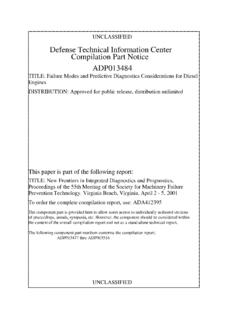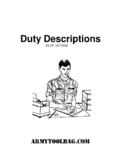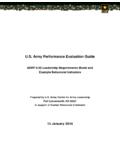Transcription of 30 Leadership - Defense Technical Information …
1 TRADOC Pamphlet 525-100-4. 30. Leadership and SCommand on the Battlefield Noncommissioned Officer Corps ta Department of the Army Headquarters United States Army Training and Doctrine Command Fort Monroe, Virginia 1994. A$W.., R - IN. W.". Information collected and assembled by CSM Robert E. Wilson Headquarters, United States Army Sergeants Major Academy Fort Bliss, Texas Edited by Dr. Susan Canedy Office of the Command Historian Headquarters, United States Army Training and Doctrine Command Fort Monroe, Virginia Graphic Design by Mrs. Linda Christensen Office of the Deputy Chief of Staff for Information Management Headquarters, United States Army Training and Doctrine Command Fort Monroe, Virginia Special thanks for assistance with format and organization of Information to Dr. Roger Spiller George C. Marshall Professor of Military History United States Army Command and General Staff College Fort Leavenworth, Kansas ceon Por NTIS CRA&M.
2 DTIC TAB. leloedS Isic Uriannounced 0. JO I pue IleAV Justification SSepo A/il!qel!eAV. uoinq1,s!Q By .. SAg DistributionI. Availability Codes u 14!eJp4srr p0ounouue,,n Dist Avail and I or Special 0 PI2 VYO SUN. uoIse8oV. THS DOCUM-ENT IS BEST. QUALITY AVAILABLE THECOPY. FURNISHED TO DTI CONTAINED. A SIGNIFICANT NUMBER OF. COLOR PAGES -WH[ICH DO NOT. REPRODUEG. L ON BLACK. AND WHITE, MICROFICHRE. i ~Commandoers Capture the successful techniques of battlefield commanders and their command sergeants major at corps, division, brigade and selected battalion levels. Specifically, investigate how they used their senior noncommissioned officers in the preparation for com- bat, during combat, and post combat operations. Identify common- alities of Leadership principles, techniques and procedures used at these levels of command during Operations JUST CAUSE and DESERT STORM.]
3 Through the use of surveys and the interview process, discover the areas that contributed to the success of the command sergeants major, the sergeants major, and the first sergeants. Question each commander and command sergeant major on the impact their senior NCOs had on the mission. The findings of this interview process will be categorized for historical and doctrinal purposes, published and distributed to the field in pamphlet format. Show how success in combat operations is directly related to utilization of senior noncommissioned officers. FREDERICK 'FRANKS ). Generli USA. "Commanding tt an OmM. * - 948 * 12 122 W. i_____. _ _ __ __ _ __. Table of Contents Introduction .. vii Chapter 1. Preparation for Combat .. 1. The Command Team .. 2. Training Assessment .. 4. Predeployment Planning .. 6. Leaders' Observations .. 10. Chapter 2.
4 Combat Operations .. 11. Combat Roles .. 12. Command Confidence .. 13. Combat Position .. 14. Leaders' Observations .. 18. Chapter 3. Post Combat Operations .. 19. Mission Adjustment .. 20. Sustainment .. 22. Leaders' Observations .. 24. Chapter 4. Sustaining Success .. 25. Discipline Standards .. 26. Training .. 28. Leader Development .. 30. Leaders' Observations .. 32. Sum m ary .. 33. Appendix A. Bullet Comments of Trends .. 37. Appendix B. Survey Questions .. 39. Appendix C. Leaders Acknowledgment .. 43. V. Introduction This battlefield, as every other battlefield for this American Army, validated the wisdom of the noncommissioned officer corps and the often repeated comment, "NCOs are the backbone of the Army.". LTG Frederick M. Franks, Jr. Cdr, VII Corps DESERT STORM. This pamphlet is the fourth in a series undertaken in an effort to capture the battle command successes of JUST CAUSE and DESERT STORM.
5 The first pamphlet focused on commonalities and trends of successful battlefield commanders at brigade, divi- sion, and corps. The second pamphlet examined the same issues from the viewpoint of battalion and company commanders. This pamphlet focuses on how senior NCOs functioned in these opera- tions, the relationships they shared with their commanders, and trends of success at battalion, brigade, and division levels. The Army proved through JUST CAUSE and DESERT STORM. that it is a force of well trained, highly disciplined soldiers. It is an Army fully capable of using modern weapons systems. The Army has successfully integrated detailed doctrine, officer and NCO. Leadership , and motivated soldiers to defeat the enemy on the battlefield. This pamphlet, for historical purposes, seeks to determine the role of senior NCOs in pre-combat, combat, and post-combat situa- tions.
6 To meet this task, the words and interviews of commanders and NCOs are used to tell how doctrine and principles were trans- formed into the training standards and battle drills of success. There is no attempt in this booklet to establish doctrine or policy. Rather, it is an attempt to capture how senior NCOs performed their tasks and responsibilities in combat operations. viA.. , . , : - . - : All commanders and NCOs were asked the same questions, centered on their experiences in JUST CAUSE and DESERT. STORM. Each question focused on their individual experiences and their opinion about senior NCOs in both operations. The questions asked are presented in Appendix B. The Army is changing its focus to a CONUS-based force capable of global power projection. It is essential to keep the fighting edge and Technical expertise of soldiers within this changing Army, and that rests on a strong corps of noncommissioned officers.
7 The insights shared in this pamphlet outline several key elements of success which will never change-training to standards and leader development. The challenge to the noncommissioned officer corps is to combine the insights presented here with experience, to step out in front of the soldiers, and lead them to victory in the United States Army of the future. viii I. Chapter 1. Preparation for Combat I trusted my NCOs and I had confidence in their ability to take care of me during combat. Also, I was trained well by my sergej1-if something had happened to Aim, I was prel to step forward into his position. R- ' U* L- ier In t neral Fred- ck ..ir t inNCOswas a key to the' I#90 ier told me two important things," Franks said, 'h'ey all stated that their training was criticalinpreparingthem for the unknowns of combat, and they praised the sergeants who had ensured they were ready for battle.
8 This is a reflection of the competence and abilitiesof the NCOs the soldier sees; not just those in the soldier's immediate chain of command, but those who make up the NCO structure in a unit.". Thus goes the story of success for the NCO Corps in Operations JUST CAUSE and DESERT STORM. Soldiers continually stressed the importance of preparation for deployment and combat. :i1. Leadershipand Command on the Battlefield Additionally, they felt it was important for soldiers to see their first sergeants and command sergeants major up front, enduring the rigors and hazards. When soldiers passed out credit for combat success, it went to realistic training, predeployment checks, battle drills, and careful attention of NCOs ensuring each soldier's family was cared for prior to development. FM 25- 101, Battle FocusedTraining, states, "The proper execu- tion of training to standard is a difficult but rewarding process.
9 It places a significant burden on the trainer in terms of preparation and assessment of performance. The payoff for properly executed training is a unit trained to standard on its wartime mission." The command sergeant major and first sergeant were key players in the assessment process and helped in preparing soldiers for deploy- ment and ultimately combat operations. Senior NCOs were respon- sible for all the small unit and individual training skills which led to the confident and competent soldiers of JUST CAUSE and DESERT STORM. This chapter focuses on the role of the senior NCO in the preparation for combat. THE COMMAND TEAM. In previous pamphlets, battalion and company commanders asserted that teamwork and cohesion within their unit, with other units, and with other services played a major role in the success of Operations JUST CAUSE and DESERT STORM.
10 That teamwork and cohesion was normally characteristic of the relationships between commanders and their senior NCOs. Throughout the interviews commanders and command ser- geants major stressed the importance established relationships played in unit readiness for JUST CAUSE and DESERT STORM. Redefining relationships and establishing duty descriptions did not enter into the predeployment equation. "?vfy commander's charterto me was to continue to do the things that we had talked about and had been workingon priorto departure to SaudiArabia,"one command sergeant major stated. Once in the 4 desert, his commander did not change the charter. The sergeant major continued his focus on day to day activities, troop observa- tions, and training assessment. He maintained his dialogue with soldiers and NCOs and functioned as another set of eyes and ears 2.













